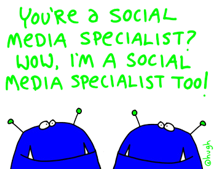 Sometimes just getting started with something new can be intimidating. Social media sounds a little scary. And many small businesses are still trying to discover how they can implement social media into their marketing plans. It’s really not that difficult. And it doesn’t have to be that time consuming. But it does take a little understanding and planning.
Sometimes just getting started with something new can be intimidating. Social media sounds a little scary. And many small businesses are still trying to discover how they can implement social media into their marketing plans. It’s really not that difficult. And it doesn’t have to be that time consuming. But it does take a little understanding and planning.
Web 2.0
You’ve probably heard of Web 2.0, but have wondered what it means. It simply signifies the second generation of usage of the Internet to convey information to clients. If you think of Web 1.0 as simple websites — basically brochures online — then Web 2.0 is the next step of actual interaction online with your customers. Today we’ll cover some of the basics of the most commonly used systems for interacting with your customers online: blogs, Facebook and Twitter.
Blogs
Blogs have been around so long that people tend to forget about them as part of Web 2.0, but they’re an important element of your online marketing plans. For years we’ve instructed companies to find ways to make their website informative and useful. Ways to keep the content fresh and up-to-date. And ways to keep visitors returning to your website. A blog is an excellent vehicle to do just that. Though we’ll discuss next time more in-depth ways to develop content for a blog, think about what type of information would be useful to your clients and prospective customers. Think about how you can position yourself as an expert with valuable knowledge.
There are a number of ways to create a blog. There are online services such as WordPress and Blogspot that make it quite easy to start a blog. But the best method is to add a blog directly to your website. There are a number of benefits to adding the blog to your site. In particular, it allows you greater control of the look and feel of the blog, and the search engines will like your site more if the blog is part of your site. I suggest the blog to go somewhere like: www.YourSite.com/blog/. You can check with your hosting company to see if adding the blog to your current website is possible. With many of the national hosting companies, adding a blog to your site is as simple as a few clicks.
I’d give you a link to our blog, but you’re already on it!
Facebook
I have to admit that I’d been a bit slow to embrace Facebook. But now that I have, I’ve certainly found it to be enjoyable. It’s allowed me to re-connect with plenty of old friends. And it has opened up doors to plenty of potential customers.
You want to make sure you setup what Facebook calls a “fan” page, and not a personal page, often referred to as a profile. With a fan page, anybody can view the content on the page. And anybody with a personal Facebook profile can “like” your page. Once a person “likes” your page, which for them as as easy as a mouse click, when you post something on your fan page, it places the comment on your fans’ news feed.
You can view our Facebook page here.
Facebook made a recent change to how customers interact with your fan page. In the past, they used to refer to this as “become a fan”, but now it’s just a “like” button on your fan page.
Twitter
As far as I’m concerned, the jury is still out on the effectiveness of Twitter for a small business. Though I would still implement this as part of your Web 2.0 marketing plan. Twitter is a way to quickly and easily convey small bits of information to your followers. People with Twitter accounts decide to “follow” people and businesses. And when the people and businesses they follow tweet, post a comment on their Twitter account, the tweet shows up in the follower’s Twitter feed.
The drawback is that unless most of your customers are college students, they’re probably not using Twitter. But many businesses are beginning to use Twitter, and it’s better to be on the front of this curve than behind it.
You can view our Twitter account here.
Next Time
Integrating Web 2.0 into your company’s marketing plans is smart business. Learning how to develop content is the next step in utilizing social media for a small business. Next time we’ll talk about how to develop content, and how to efficiently and effectively utilize that content across your different applications. So until then, happy marketing!
Cartoon from Gapingvoid.

